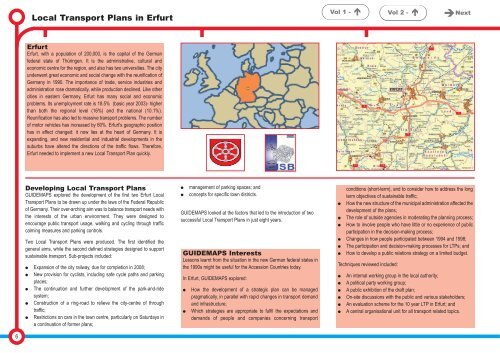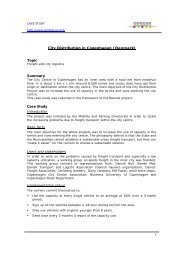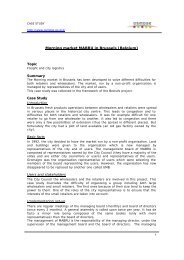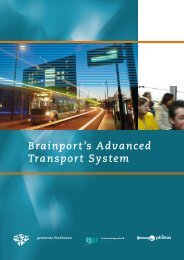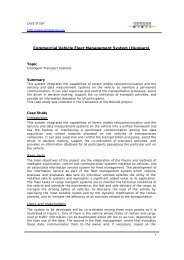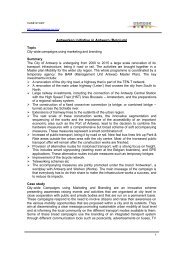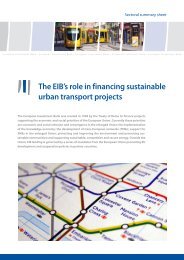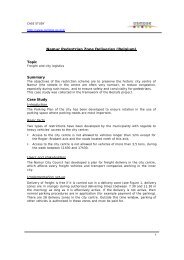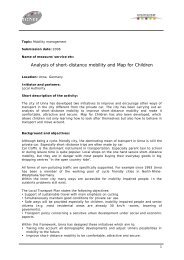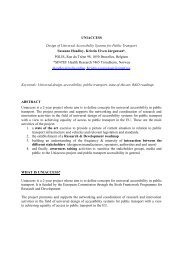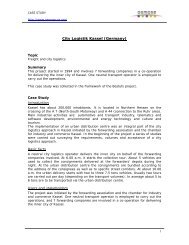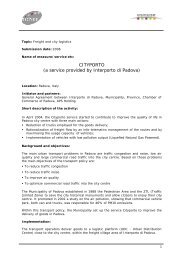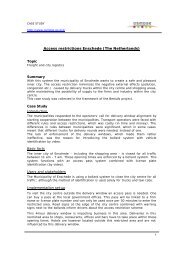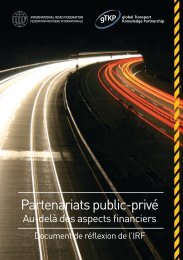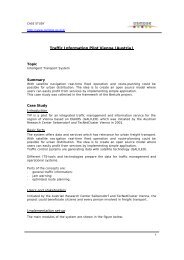Successful transport decision-making - Osmose
Successful transport decision-making - Osmose
Successful transport decision-making - Osmose
You also want an ePaper? Increase the reach of your titles
YUMPU automatically turns print PDFs into web optimized ePapers that Google loves.
Local Transport Plans in Erfurt<br />
Vol 1 - !<br />
Vol 2 - !<br />
" Next<br />
Erfurt<br />
Erfurt, with a population of 200,000, is the capital of the German<br />
federal state of Thüringen. It is the administrative, cultural and<br />
economic centre for the region, and also has two universities. The city<br />
underwent great economic and social change with the reunification of<br />
Germany in 1990. The importance of trade, service industries and<br />
administration rose dramatically, while production declined. Like other<br />
cities in eastern Germany, Erfurt has many social and economic<br />
problems. Its unemployment rate is 18.5% (basic year 2003)- higher<br />
than both the regional level (16%) and the national (10.1%).<br />
Reunification has also led to massive <strong>transport</strong> problems. The number<br />
of motor vehicles has increased by 60%. Erfurt's geographic position<br />
has in effect changed: it now lies at the heart of Germany. It is<br />
expanding, and new residential and industrial developments in the<br />
suburbs have altered the directions of the traffic flows. Therefore,<br />
Erfurt needed to implement a new Local Transport Plan quickly.<br />
Developing Local Transport Plans<br />
GUIDEMAPS explored the development of the first two Erfurt Local<br />
Transport Plans to be drawn up under the laws of the Federal Republic<br />
of Germany. Their over-arching aim was to balance <strong>transport</strong> needs with<br />
the interests of the urban environment. They were designed to<br />
encourage public <strong>transport</strong> usage, walking and cycling through traffic<br />
calming measures and parking controls.<br />
Two Local Transport Plans were produced. The first identified the<br />
general aims, while the second defined strategies designed to support<br />
sustainable <strong>transport</strong>. Sub-projects included:<br />
! Expansion of the city railway, due for completion in 2008;<br />
! New provision for cyclists, including safe cycle paths and parking<br />
places;<br />
! The continuation and further development of the park-and-ride<br />
system;<br />
! Construction of a ring-road to relieve the city-centre of through<br />
traffic;<br />
! Restrictions on cars in the town centre, particularly on Saturdays in<br />
a continuation of former plans;<br />
! management of parking spaces; and<br />
! concepts for specific town districts.<br />
GUIDEMAPS looked at the factors that led to the introduction of two<br />
successful Local Transport Plans in just eight years.<br />
GUIDEMAPS Interests<br />
Lessons learnt from the situation in the new German federal states in<br />
the 1990s might be useful for the Accession Countries today.<br />
In Erfurt, GUIDEMAPS explored:<br />
! How the development of a strategic plan can be managed<br />
pragmatically, in parallel with rapid changes in <strong>transport</strong> demand<br />
and infrastructure;<br />
! Which strategies are appropriate to fulfil the expectations and<br />
demands of people and companies concerning <strong>transport</strong><br />
conditions (short-term), and to consider how to address the long<br />
term objectives of sustainable traffic;<br />
! How the new structure of the municipal administration affected the<br />
development of the plans;<br />
! The role of outside agencies in moderating the planning process;<br />
! How to involve people who have little or no experience of public<br />
participation in the <strong>decision</strong>-<strong>making</strong> process;<br />
! Changes in how people participated between 1994 and 1998;<br />
! The participation and <strong>decision</strong>-<strong>making</strong> processes for LTPs; and<br />
! How to develop a public relations strategy on a limited budget.<br />
Techniques reviewed included:<br />
! An internal working group in the local authority;<br />
! A political party working group;<br />
! A public exhibition of the draft plan;<br />
! On-site discussions with the public and various stakeholders;<br />
! An evaluation scheme for the 10 year LTP in Erfurt; and<br />
! A central organisational unit for all <strong>transport</strong> related topics.<br />
6


